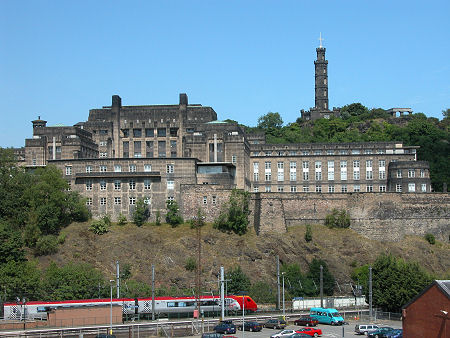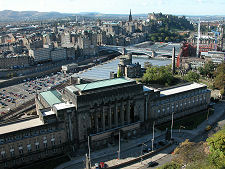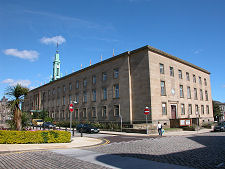 St Andrew's House from the South |
Thomas Smith Tait, or "Tommy", lived from 1882 to 1954. Between the wars, he was Scotland's foremost architect and is remembered in his own country primarily for St Andrew's House in Edinburgh, headquarters of the Scottish Office and, since 1997, of the devolved Scottish Executive. The wider picture in Scotland at the time is set out in our Historical Timeline.
Tait was born in Paisley, and studied at the John Neilson Institution before starting work as an apprentice architect with James Donald in Paisley. He then attended Glasgow School of Art, and spent 1904 and 1905 travelling Europe, before settling in London where he worked for the prestigious architectural practice of Sir John James Burnet. By 1910, Tait was a leading member of Burnet's staff, and played an important part in the design of the Kodak Building in London, considered to be among the first examples of modern architecture in the United Kingdom.
In order to supplement his income following marriage to Constance Hardy in 1910, Tait did additional work for another architectural practice, Trehearne and Norman, designing a number of large office blocks in London for them. This caused a rift between Tait and Sir John Burnet, and Tait went to work in New York as an assistant to Donn Barber.
In 1919, Tait, by now back on good terms with Burnet, became a partner in the practice, which became known as Burnet, Tait and Lorne. The practice was right at the forefront of modernism and amongst the designs for which Tait was personally responsible were Adelaide House on the Thames; the Daily Telegraph office in London; and the pylons for Sydney Harbour Bridge. In 1932 he was able to have an impact on his home town when he designed Paisley's Hawkhead Hospital. He was also the assessor in the architectural competition to build a new Town House in Kirkcaldy. His work on the Royal Masonic Hospital at Ravenscourt won Tait the RIBA Gold Medal for the best building of 1933.
St Andrew's House in Edinburgh emerged between 1934 and 1939, on land previously used for a prison at the foot of Calton Hill. The site sloped steeply down to the south to the main line railway into Edinburgh's Waverley Station. Described by its fans as "monolithic, symmetrical and sober from the front, romantically irregular from the South", and by more neutral observers as having "brooding authority", it has also been referred to, more than once, as "The Kremlin". But love it or loath it, St Andrews' House dominates many views across Edinburgh.
More transient was the work Tait did for the Empire Exhibition held in Glasgow's Bellahouston Park between May and December 1938. Tait was appointed to lead a team of nine architects working on the exhibition, who included Basil Spence and Jack Coia. The result was the largest collection of modern architecture built in the United Kingdom in the first half of the 20th century. Tait himself was responsible for the 300ft tall art deco "Tower of Empire", also referred to as Tait Tower or Tait's Tower, that stood on top of the hill in the park and became the focus of the exhibition. The Empire Exhibition was a huge success, attracting over 12 million visitors.
Tait Tower could be seen from 100 miles away. Despite an urban myth that its removal was to avoid it being used as a navigational aid by German bombers in World War II, the tower was only ever intended to be a temporary structure for the exhibition, and its removal began in July 1939. The 3,000 ton block of concrete into which it was anchored remains a feature of Bellahouston Park.
Demand for architects disappeared during World War II, and Tait became Director of Standardisation at the Ministry of Works between 1940 and 1942. He resumed his architectural practice after the war, and though he formally retired in 1952, he remained a consultant until his death in 1954 at the age of 72.


